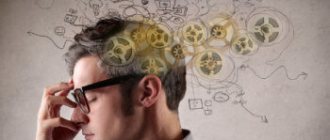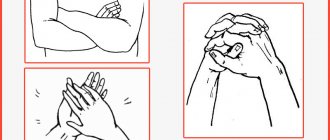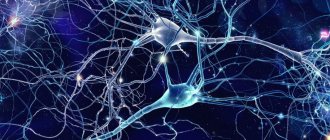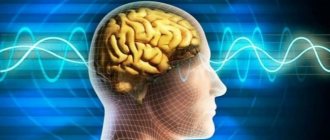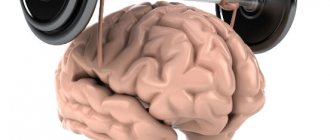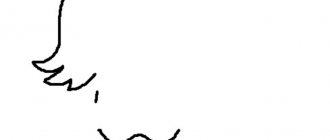Each hemisphere of our brain is responsible for a specific area of activity. Right - for spatial orientation, creative (musical, theatrical, artistic and other) abilities, non-verbal attitude, imagination. The specialization of the left hemisphere is analytical and logical thinking, mathematical abilities, speech perception - oral and written, memory, aptitude for learning foreign languages. Human mental abilities directly depend on the coordinated work of both hemispheres.
Necessary conditions for child brain development
Nature has provided the human brain with a huge number of neurons that make up its core. Their diverse connections provide consciousness, thinking, memory, coordination and functioning of the entire organism. It is their formation that ensures the development of the brain.
The active process occurs until the child is three years old, after which the rate of development decreases significantly. Full physiological formation is completed by the age of 6-7, when a person is completely ready to perceive information, analyze it and conscious mental activity.
Researchers identify the following important factors influencing brain development:
- Speech. Verbal information received by the child becomes the main stimulant. The earlier and more language exposure an infant receives, the faster the brain develops. Verbal information stimulates the formation of connections for processing incoming information. It is important to understand that it is impossible to utter any word without hearing it at least once. Parental speech establishes vocabulary and communication skills in the first 2-3 years after birth.
- Stability and stress. The baby's brain instantly reacts to any external stimuli. A stable, calm environment provides normal conditions for development. Stresses that generate internal irritants become depressing factors for him. The child’s brain completely switches to such influences. Prolonged stressful situations lead to the production of cortisol and other dangerous hormones that change the entire brain structure.
- Emotions. Positive emotions in a child contribute to normal brain development. The caring attitude of parents and a favorable external environment create the basis for the formation of a response to future learning. It establishes trust and the necessary relationships between the baby and adults.
- Praise. Research has shown that praising a child's efforts between the ages of 1 and 3 stimulates a desire to broaden his or her horizons in the future. It is important to understand that rewarding diligence, not praising innate talents, has a positive effect.
- Cry. It has been established that the lack of response to a baby's crying disrupts normal brain development, increasing the impact of harmful stress. Parents' attention to their baby's crying lays the foundation for trust and affection.
There is considerable debate about the impact of television on a child's brain development. Most psychologists agree that it cannot be considered an assistant in this important process. Television information is practically not deposited in the infant brain. At the same time, the same information heard from the mother’s lips is absorbed well.
Exercises to develop the left hemisphere
The human brain is designed in such a way that its hemispheres are endowed with different abilities. The left hemisphere is responsible for the following functions:
Analytical thinking, logic and reasoning. Facts are analyzed, numbers and mathematical symbols are recognized.
- Language abilities, understanding the literal meaning of words.
- Sequential, step-by-step processing of information.
- Mathematical abilities.
- Reading and writing abilities.
In addition to analysis and logical thinking, this hemisphere controls the movement of the right half of the body.
To develop the left hemisphere, the following exercises are recommended:
- Daily solution of mathematical problems with elements of logic. They are compiled taking into account the age of the child. You can give an example of a simple task. Two children (A and B) received a box of chocolates with 10 candies as a gift. One of them (A) ate some sweets from his box, and B ate all the rest in it. Question: how many sweets do the children have left between them? The answer is candy in the 20th, i.e. 10 pieces.
- Solving crosswords, chainwords, puzzles. You can pay attention to a popular trend - Sudoku.
- Physical exercise. Priority is placed on moving the right limbs and loading all types of muscles located on the right side of the body.
- Massage. Points that stimulate the functioning of the cerebellum have been identified. Massaging the point located at the base of the big toe on the right foot helps.
Important! For the development of the left hemisphere of the brain, training in logic and ingenuity is useful. It should be noted that the school curriculum is largely aimed at the development of this particular hemisphere.
Window
Development of holistic visual perception
To whom and why? It will help those who have difficulty retelling the text and understanding the meaning of the text. Develops logical and imaginative thinking.
What to do? A large, detailed picture is covered with a sheet of paper with a window. By moving the sheet, objects are not shown as a whole, but only part of them (for example, half a clock). The child must recognize and name the objects he sees through the window. And then imagine and describe the whole picture. For example: “The picture shows a room, a girl is sitting in a green chair, a kitten is peeking out from under the table...”
Recommended image format is A4 or A5. The size of the sheet with the window should be twice the size of the picture. Window size 2 x 2 cm.
Play smart and your brain will thank you
Did you like the article? Tell your friends:
Exercises to develop the right hemisphere
The right hemisphere of the brain is responsible for the following functions:
- Spatial orientation. The right hemisphere allows you not only to navigate the terrain, but also to put together a mosaic, assemble a construction set, etc.
- Musical abilities. In this hemisphere the perception of music is ensured, but musical education itself is obtained at the expense of the left hemisphere.
- Understanding metaphors and other people's imagination and fantasies.
- Developing your own fantasies, daydreaming.
- Artistic abilities.
- Emotionality.
- Mysticism and religiosity.
Essentially, the right hemisphere provides parallel processing of information based on intuition, images, symbols, without connecting with words and letters. It helps recognize faces. In addition, the hemisphere controls the movements of the left half of the body.
The following exercises are recommended:
- Visualization of the image. You need to relax and imagine a sheet of white paper in front of you. To begin with, using the power of imagination, it is painted in any favorite color. Any abstract drawing is mentally drawn on the sheet. Such training should be carried out daily, changing the plot, moving from simple images to complex paintings, rich colors.
- Game with a name. The child should be asked to fantasize by relaxing and closing his eyes. Let him mentally hear that someone is calling his name. We need to find out who this voice belongs to. The next step is which melody the name goes best with. Next, you can try to feel your name by touch, smell and taste. What is it like - soft, hard, fluffy, etc. After this, the child is taken out of this state and asked to talk about associations, encouraging any comparisons. You can ask them to draw what they saw in their imaginations.
- Mirror drawing. Frequent drawing, even in the absence of special talents, develops the right hemisphere. It is not the quality of the drawing that is important, but the desire to reflect some images on paper. We need to develop a flight of fantasy. The “Mirror Drawing” exercise is especially useful. Take 2 sheets of paper and pencils in both hands. You need to draw the same drawing or pattern with both hands at the same time. You should relax while performing the exercise.
- Playing a musical instrument. The guitar fits well. It is not at all necessary to know how to play it. It is enough to lightly pluck the strings, trying to reproduce a melody, and imagine that the idea was a success. If a child owns a musical instrument, then he should play it daily.
- "Ring". The exercise is very simple. Without looking at your hand, you need to alternately touch the fingertips of your left hand with your thumb, forming a ring. The exercise is done many times throughout the day.
Important! Exercises that load the left half of the body allow you to develop the right hemisphere. Similar to the technique described above, you can massage the base of the big toe of your left foot.
Mirror drawing
It allows you to develop concentration, attentiveness, and accuracy. Very suitable for children who are quite active and may be somewhat loose. Helps you get ready. Develops spatial awareness, has a positive effect on imaginative thinking and even improves a child’s handwriting.
What to do? The child is given the drawing upside down. The drawing can be of any kind, of different levels of complexity, depending on the age of the child.
It is desirable that there are many small details present.
The child needs to look carefully at the drawing and draw the same one, but not upside down.
To whom and why? Helps children who generally have disinhibited behavior, those who find it difficult to sit still, and anyone who is easily distracted by something. The exercise also helps to solve some problems with writing, if, for example, the child mirrors letters or misses letters. This exercise primarily controls your activity, attentiveness and accuracy.
Exercises to develop two hemispheres at the same time
It is very important for a child to ensure the development of both hemispheres of the brain. To do this, simple exercises are carried out to train them simultaneously:
- The left hand rests on the right shoulder, the head turns to the right, and the gaze is directed to a specific object. The head then slowly turns to the left to look over the left shoulder. The exercise is repeated in a similar way for the right arm and left shoulder.
- A sheet of paper is taken in both hands. They need to wave, simultaneously using the hands, elbows and shoulders.
- Starting position: hands on the back of the chair, one leg moves back, body leans slightly forward. A squat is done on one leg with the entire body weight transferred to it. Then, slowly the body weight moves to the back leg. After 5 repetitions, the legs change.
- One hand is clenched into a fist, and the palm of the other is completely straightened. Then, the hand movements change. The fist-palm cycle is performed slowly at first, and then the pace accelerates.
- The fingers of the right hand touch the nose, and the left hand touches the right ear. Then, there is a clap of hands, and the hands change places.
- The right hand is brought to the temple (“under the visor”), and the left hand shows the characteristic gesture “Cool!” Then the hands change places.
- On one hand, the fingers depict the letter V, and on the other, O. The hands periodically change places.
- With the fingers of one hand you need to show the “legs”, and with the other hand – the “horns”, periodically changing hands.
- Finger puzzles. The index and middle fingers are used on one hand, the little and ring fingers on the other. The fingers fit together to imitate puzzles.
- At the same time, on both hands, the thumb alternately touches the other fingers. Moreover, on one hand the exercise begins with the little finger, and on the other - with the index finger.
Important! The goal of joint training is to coordinate the actions of both hemispheres. When carrying out the exercises systematically, their synchrony and optimal relationship are established.
The human brain is a complex mechanism that requires special training for normal functioning. From early childhood it is necessary to take measures to improve it. The right and left hemispheres perform their own specific functions, and therefore the methods of their development also differ. Exercises to coordinate their work are especially important.
Find out more about it
You don't need to be Da Vinci to sharpen your mind, says Michael Candle.
The first person to write about the use of two-handed writing in personal therapy was art therapist Lucia Capaccione, who published The Power of the Other Hand in 1988. Her numerous works and publications describe how this technique can be used for the creativity and development of adults, adolescents and children. The exercises she suggests make it easier to learn two-handed writing - like riding a bicycle, this is a path from awkwardness and clumsiness to simplicity and naturalness. In 2021, another book by Capaccione was published in Russia - “The Art of Finding Yourself. Expressive diary."


